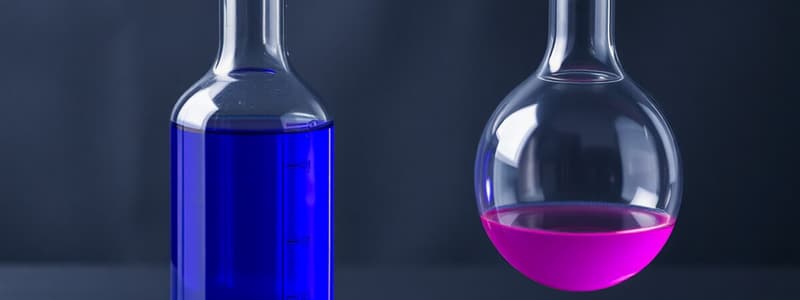Podcast
Questions and Answers
The mass of each element in a compound is determined by dividing the total molar mass by the number of atoms of each element.
The mass of each element in a compound is determined by dividing the total molar mass by the number of atoms of each element.
False (B)
To find the empirical formula from a percent composition, one must first convert the percentages directly to grams assuming a 100 g sample.
To find the empirical formula from a percent composition, one must first convert the percentages directly to grams assuming a 100 g sample.
True (A)
The empirical formula for a compound with 40% Carbon, 6.7% Hydrogen, and 53.3% Oxygen is C₂H₆O₂.
The empirical formula for a compound with 40% Carbon, 6.7% Hydrogen, and 53.3% Oxygen is C₂H₆O₂.
False (B)
To determine the percent composition of an element in a compound, the formula used is the mass of the element in one mole divided by the molar mass of the compound, multiplied by 100.
To determine the percent composition of an element in a compound, the formula used is the mass of the element in one mole divided by the molar mass of the compound, multiplied by 100.
Hydrogen has a molar mass of 2.02 g/mol when calculating the percent composition of water.
Hydrogen has a molar mass of 2.02 g/mol when calculating the percent composition of water.
When finding the empirical formula, if the ratio of moles is not a whole number, it can be adjusted by multiplying all ratios by the smallest integer that converts them to whole numbers.
When finding the empirical formula, if the ratio of moles is not a whole number, it can be adjusted by multiplying all ratios by the smallest integer that converts them to whole numbers.
Covalent bonds are formed through the transfer of electrons between atoms.
Covalent bonds are formed through the transfer of electrons between atoms.
Ionic bonds typically form between metal and nonmetal atoms.
Ionic bonds typically form between metal and nonmetal atoms.
Metallic bonds allow atoms to form covalent structures that are non-conductive.
Metallic bonds allow atoms to form covalent structures that are non-conductive.
Polar bonds occur when electrons are shared equally between two atoms.
Polar bonds occur when electrons are shared equally between two atoms.
Bond length is the distance between the nuclei of two bonded atoms.
Bond length is the distance between the nuclei of two bonded atoms.
The strength of a chemical bond is influenced by the temperature of the surrounding environment.
The strength of a chemical bond is influenced by the temperature of the surrounding environment.
Balancing chemical equations involves ensuring that the number of atoms remains constant on both sides.
Balancing chemical equations involves ensuring that the number of atoms remains constant on both sides.
Polyatomic ions should be balanced as individual atoms when balancing equations.
Polyatomic ions should be balanced as individual atoms when balancing equations.
In redox reactions, it is unnecessary to adjust for charge when balancing chemical equations.
In redox reactions, it is unnecessary to adjust for charge when balancing chemical equations.
A mole contains exactly 6.02214076 × 10^22 elementary entities.
A mole contains exactly 6.02214076 × 10^22 elementary entities.
To balance a chemical equation, one should adjust the coefficients in simplest possible whole number ratios.
To balance a chemical equation, one should adjust the coefficients in simplest possible whole number ratios.
The molar mass of carbon dioxide (CO₂) is calculated as 12.01 g/mol for carbon and 32.00 g/mol for oxygen.
The molar mass of carbon dioxide (CO₂) is calculated as 12.01 g/mol for carbon and 32.00 g/mol for oxygen.
Polyatomic ions can be balanced individually when they appear unchanged on both sides of the equation.
Polyatomic ions can be balanced individually when they appear unchanged on both sides of the equation.
To calculate the number of moles, the formula used is Mass of substance divided by Molar mass.
To calculate the number of moles, the formula used is Mass of substance divided by Molar mass.
If you have 36 grams of water, it corresponds to exactly 3 moles of water molecules.
If you have 36 grams of water, it corresponds to exactly 3 moles of water molecules.
Avogadro's number specifically applies only to molecules and not to atoms or ions.
Avogadro's number specifically applies only to molecules and not to atoms or ions.
The first step in balancing chemical equations involves counting the total charges on both sides.
The first step in balancing chemical equations involves counting the total charges on both sides.
The atomic weight of substances in grams directly corresponds to the number of moles present.
The atomic weight of substances in grams directly corresponds to the number of moles present.
In redox reactions, it's necessary to balance both the number of atoms and the total charge on both sides of the equation.
In redox reactions, it's necessary to balance both the number of atoms and the total charge on both sides of the equation.
Flashcards are hidden until you start studying
Study Notes
Chemical Bonding
- Chemical bonding occurs when atoms share or transfer electrons to achieve stability.
- Covalent bonds involve atoms sharing electrons, typically between nonmetal atoms.
- Ionic bonds involve the transfer of electrons between a metal and nonmetal, forming oppositely charged ions.
- Metallic bonds are characterized by electrons shared among a lattice of metal atoms, enabling electrical and thermal conductivity.
Balancing Chemical Equations
- Balancing chemical equations ensures that the same number of each type of atom is present on both sides of the equation, reflecting the law of conservation of mass.
- Start with the correct formulas for reactants and products.
- Count the atoms of each element on both sides.
- Balance one element at a time using coefficients to adjust the number of atoms.
- If a polyatomic ion remains unchanged, balance it as a unit.
- Ensure that the coefficients are in the simplest possible whole-number ratio.
- In redox reactions, make sure the total charge is balanced on both sides.
The Mole
- A mole is a unit of measurement in chemistry representing the amount of substance containing Avogadro's number (6.02214076 × 10²³) of elementary entities.
- The mole allows chemists to count atoms or molecules by weighing them.
- One mole of a substance has a mass in grams equal to its atomic or molecular weight.
- The mole is crucial in stoichiometry, the study of the quantitative relationships between reactants and products in chemical reactions.
Calculating Number of Moles
- The number of moles (n) in a substance can be calculated using the formula:
- n = mass (g) / molar mass (g/mol)
- To calculate the number of moles, you need the mass of the substance in grams and its molar mass (g/mol).
- Molar mass is the mass of one mole of the substance and is found by adding the atomic masses of all atoms in a molecule.
Percentage Composition
- Percentage composition represents the proportion of each element in a compound by mass.
- To calculate percent composition:
- Determine the molar mass of the compound.
- Calculate the mass of each element in one mole of the compound.
- Divide the mass of the element by the molar mass of the compound and multiply by 100%.
Empirical Formula
- The empirical formula represents the simplest whole-number ratio of different atoms in a compound.
- To find the empirical formula:
- Determine the mass or percentage composition of each element.
- Convert mass (or percentage) to moles by dividing by atomic mass.
- Find the simplest ratio of moles by dividing by the smallest number of moles calculated.
- If necessary, adjust the ratios to whole numbers.
Studying That Suits You
Use AI to generate personalized quizzes and flashcards to suit your learning preferences.




